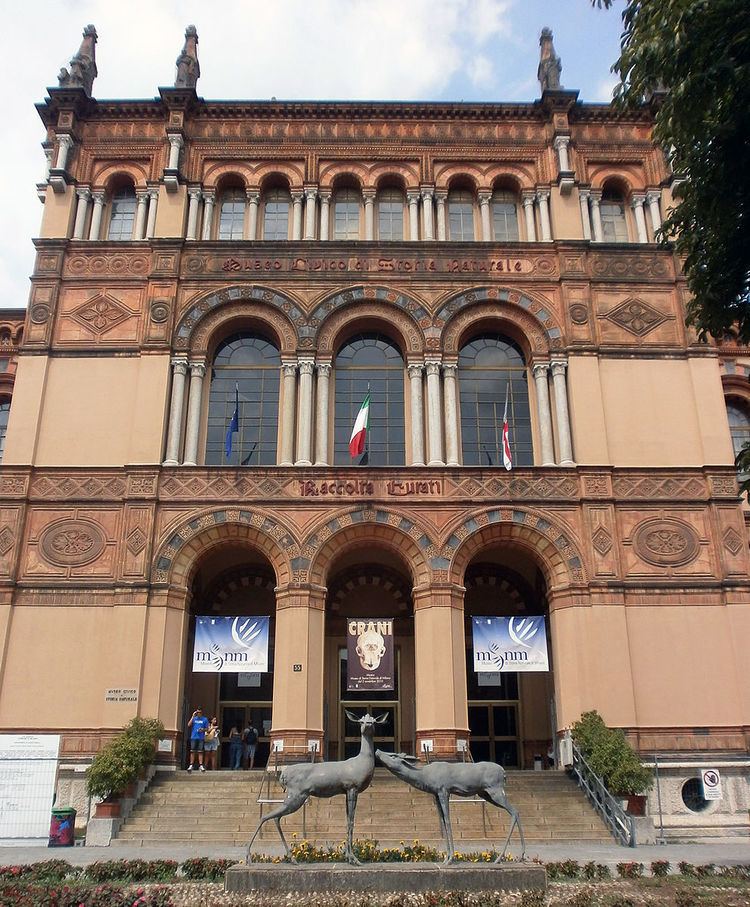Established 1838 Website Official website | Director Domenico Piraina Phone +39 02 8846 3337 | |
 | ||
Address Corso Venezia, 55, 20121 Milano, Italy Hours Open today · 9AM–5:30PMWednesday9AM–5:30PMThursday9AM–5:30PMFriday9AM–5:30PMSaturday9AM–5:30PMSunday9AM–5:30PMMondayClosedTuesday9AM–5:30PMSuggest an edit Similar Galleria d'Arte Moderna, Museum of the Risorgimento, Sforza Castle, Civic Aquarium of Milan, Villa Belgiojoso Bonaparte | ||
The Museo Civico di Storia Naturale di Milano (Milan Natural History Museum) was founded in 1838 when naturalist Giuseppe de Cristoforis (1803–1837) donated his collections to the city of Milan, Italy. Its first director was Giorgio Jan (1791–1866).
Contents
- Mineralogy section
- Paleontology section
- Natural history of man section
- Invertebrate Zoology section
- Vertebrate Zoology section
- Directors of the museum
- References
The Milan Natural History Museum is located within a 19th-century building in the Indro Montanelli Garden, near the historic city gate of Porta Venezia. The structure was built between 1888 and 1893 in Neo-Romanesque style with Gothic elements.
The museum is divided into five different permanent sections: Mineralogy (with a large collection of minerals from all over the world); Paleontology (with several fossils of dinosaurs and other prehistoric organisms); Natural History of Man (dedicated to the origins and evolution of humans with a particular attention to the relationship of the latter with the environment); Invertebrate Zoology (dedicated to mollusks, arthropods and entomology); and Vertebrate Zoology (dedicated to vertebrates, both exotic and European).
The museum also exhibits the largest Italian collection of full size dioramas (over 100) that allow visitors to observe some peculiar aspects of various ecosystems.
Mineralogy section
The mineralogy section showcases several minerals from all over the world including the world's largest sulfur crystal (from the province of Pesaro-Urbino) and an 8,000 carat Brazilian topaz crystal. Also displayed are examples of londonite, quarz, phosgenite, fluorite, malachite and other minerals.
Paleontology section
This section explains the basics of paleozoology and paleobotany. Displays include fossils of several plants and animals. Among the most valuable specimens are the skeletons of two pygmy elephants (Palaeoloxodon falconeri) from Sicily and the only existing fossil of the coelurosaurian theropod Scipionix samniticus. The museum also houses several other casts of dinosaur skeletons such as Allosaurus, Stegosaurus, Dromaeosaurus, and Plateosaurus.
Natural history of man section
This section is dedicated to the origins of humans from early primates to Homo sapiens. Human evolution is described from the phylogenetic, morphological and ecological points of view with several archaeological objects and realistic plastic models. One of the most valuable pieces is the cast of an Australopithecus afarensis skeleton.
Invertebrate Zoology section
This section is divided in two exhibitions. The first is about mollusks and arthropods: displays include a giant clam, which is the largest living bivalve, two Japanese spider crabs (male and female), Scolopendra gigantea, and arachnids like many spiders and scorpions from all over the world. The second exhibition is dedicated to entomology and displays many insects.
Vertebrate Zoology section
On the second floor of the building is the vertebrate zoology section: this section displays many taxidermied animals from both Europe and abroad, and many animal skeletons including that of a sperm whale that measures approximately twelve metres in length. There are also many full-scale dioramas with mounted specimens displayed in realistic settings.
